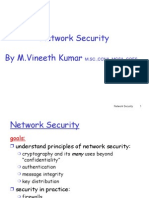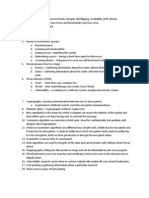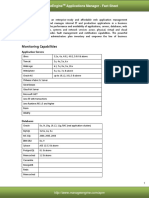James Won-Ki Hong: Department of Computer Science and Engineering POSTECH, Korea
James Won-Ki Hong: Department of Computer Science and Engineering POSTECH, Korea
Uploaded by
syedpandtCopyright:
Available Formats
James Won-Ki Hong: Department of Computer Science and Engineering POSTECH, Korea
James Won-Ki Hong: Department of Computer Science and Engineering POSTECH, Korea
Uploaded by
syedpandtOriginal Title
Copyright
Available Formats
Share this document
Did you find this document useful?
Is this content inappropriate?
Copyright:
Available Formats
James Won-Ki Hong: Department of Computer Science and Engineering POSTECH, Korea
James Won-Ki Hong: Department of Computer Science and Engineering POSTECH, Korea
Uploaded by
syedpandtCopyright:
Available Formats
James Won-Ki Hong
Department of Computer Science and Engineering
POSTECH, Korea
jwkhong@postech.ac.kr
POSTECH CSED702D: Internet Traffic Monitoring and Analysis 1/39
Outline
What is Wireshark?
Capturing Packets
Analyzing Packets
Filtering Packets
Saving and Manipulating Packets
Packet Statistics
Colorizing Specific Packets
References
POSTECH CSED702D: Internet Traffic Monitoring and Analysis 2/39
What is Wireshark?
The De-Facto Network Protocol Analyzer
Open-Source (GNU Public License)
Multi-platform (Windows, Linux, OS X, Solaris, FreeBSD,
NetBSD, and others)
Easily extensible
Large development group
Previously Named “Ethereal”
POSTECH CSED702D: Internet Traffic Monitoring and Analysis 3/39
What is Wireshark?
Features
Deep inspection of thousands of protocols
Live capture and offline analysis
Standard three-pane packet browser
Captured network data can be browsed via a GUI, or via
the TTY-mode TShark utility
The most powerful display filters in the industry
Rich VoIP analysis
Live data can be read from Ethernet, IEEE 802.11,
PPP/HDLC, ATM, Bluetooth, USB, Token Ring, Frame
Relay, FDDI, and others
Coloring rules can be applied to the packet list for quick,
intuitive analysis
Output can be exported to XML, PostScript®, CSV, or
plain text
POSTECH CSED702D: Internet Traffic Monitoring and Analysis 4/39
What is Wireshark?
What we can:
Capture network traffic
Decode packet protocols using dissectors
Define filters – capture and display
Watch smart statistics
Analyze problems
Interactively browse that traffic
Some examples people use Wireshark for:
Network administrators: troubleshoot network problems
Network security engineers: examine security problems
Developers: debug protocol implementations
People: learn network protocol internals
POSTECH CSED702D: Internet Traffic Monitoring and Analysis 5/39
Interfaces
Packet
List
Packet
Details
Packet
Bytes
POSTECH CSED702D: Internet Traffic Monitoring and Analysis 6/39
Capturing Packets (1/3)
POSTECH CSED702D: Internet Traffic Monitoring and Analysis 7/39
Capturing Packets (2/3)
Capture all packets on the
network
Buffer size – in order not
to fill your laptop disk
Capture filter
Display
options
Capture in Name
multiple files resolution
options
When to
automatically
stop the
capture
POSTECH CSED702D: Internet Traffic Monitoring and Analysis 8/39
Capturing Packets (3/3)
Example (W-LAN):
Received Signal Strength
Indication (RSSI) and Link
speed (BW)
POSTECH CSED702D: Internet Traffic Monitoring and Analysis 9/39
Analyzing Packets (1/9)
Ethernet Frame Example
POSTECH CSED702D: Internet Traffic Monitoring and Analysis 10/39
Analyzing Packets (2/9)
IP Packet Example
POSTECH CSED702D: Internet Traffic Monitoring and Analysis 11/39
Analyzing Packets (3/9)
TCP Packet Example
POSTECH CSED702D: Internet Traffic Monitoring and Analysis 12/39
Analyzing Packets (4/9)
TCP 3-way Handshake
POSTECH CSED702D: Internet Traffic Monitoring and Analysis 13/39
Analyzing Packets (5/9)
Flow Graph
Giving us a graphical flow, for better understanding of
what we see
POSTECH CSED702D: Internet Traffic Monitoring and Analysis 14/39
Analyzing Packets (6/9)
Flow Graph
POSTECH CSED702D: Internet Traffic Monitoring and Analysis 15/39
Analyzing Packets (7/9)
Filtering Specific TCP Stream
POSTECH CSED702D: Internet Traffic Monitoring and Analysis 16/39
Analyzing Packets (8/9)
Filtering Specific TCP Stream
POSTECH CSED702D: Internet Traffic Monitoring and Analysis 17/39
Analyzing Packets (9/9)
RTP Stream Analysis
Stable
stream BW
POSTECH CSED702D: Internet Traffic Monitoring and Analysis 18/39
Filtering Packets (1/4)
Applying Filter when Capturing Packets
Capture Interfaces Options:
POSTECH CSED702D: Internet Traffic Monitoring and Analysis 19/39
Filtering Packets (2/4)
Applying Filter when Analyzing Packets
POSTECH CSED702D: Internet Traffic Monitoring and Analysis 20/39
Filtering Packets (3/4)
Examples:
Capture only traffic to or from IP address 172.18.5.4
• host 172.18.5.4
Capture traffic to or from a range of IP addresses
• net 192.168.0.0/24
• net 192.168.0.0 mask 255.255.255.0
Capture traffic from a range of IP addresses
• src net 192.168.0.0/24
• src net 192.168.0.0 mask 255.255.255.0
Capture traffic to a range of IP addresses
• dst net 192.168.0.0/24
• dst net 192.168.0.0 mask 255.255.255.0
Capture only DNS (port 53) traffic
• port 53
Capture non-HTTP and non-SMTP traffic on your server
• host www.example.com and not (port 80 or port 25)
• host www.example.com and not port 80 and not port 25
POSTECH CSED702D: Internet Traffic Monitoring and Analysis 21/39
Filtering Packets (4/4)
Examples:
Capture except all ARP and DNS traffic
• port not 53 and not arp
Capture traffic within a range of ports
• (tcp[2:2] > 1500 and tcp[2:2] < 1550) or (tcp[4:2] > 1500 and
tcp[4:2] < 1550)
• tcp portrange 1501-1549
Capture only Ethernet type EAPOL
• ether proto 0x888e
Capture only IP traffic
(the shortest filter, but sometimes very useful to get rid of lower layer
protocols like ARP and STP)
• ip
Capture only unicast traffic
(useful to get rid of noise on the network if you only want to see traffic
to and from your machine, not, for example, broadcast and multicast
announcements)
• not broadcast and not multicast
POSTECH CSED702D: Internet Traffic Monitoring and Analysis 22/39
Saving and Manipulating Packets (1/3)
Save only displayed packets
POSTECH CSED702D: Internet Traffic Monitoring and Analysis 23/39
Saving and Manipulating Packets (2/3)
Export to CSV file
POSTECH CSED702D: Internet Traffic Monitoring and Analysis 24/39
Saving and Manipulating Packets (3/3)
Exported CSV File
POSTECH CSED702D: Internet Traffic Monitoring and Analysis 25/39
Packet Statistics (1/8)
Protocol Hierarchy
POSTECH CSED702D: Internet Traffic Monitoring and Analysis 26/39
Packet Statistics (2/8)
Conversation
Traffic between two specific endpoints
With some manipulation
POSTECH CSED702D: Internet Traffic Monitoring and Analysis 27/39
Packet Statistics (3/8)
I/O Graph
POSTECH CSED702D: Internet Traffic Monitoring and Analysis 28/39
Packet Statistics (4/8)
Configurable Options
I/O Graphs
• Graph 1-5: enable the specific graph 1-5 (graph 1 by default)
• Filter: a display filter for this graph (only the packets that pass
this filter will be taken into account for this graph)
• Style: the style of the graph (Line/Impulse/FBar/Dot)
X Axis
• Tick interval: an interval in x direction lasts
(10/1 minutes or 10/1/0.1/0.01/0.001 seconds)
• Pixels per tick: use 10/5/2/1 pixels per tick interval
• View as time of day: option to view x direction labels as time of
day instead of seconds or minutes since beginning of capture
Y Axis
• Unit: the unit for the y direction
(Packets/Tick, Bytes/Tick, Bits/Tick, Advanced...)
• Scale: the scale for the y unit
(Logarithmic,Auto,10,20,50,100,200,...)
POSTECH CSED702D: Internet Traffic Monitoring and Analysis 29/39
Packet Statistics (5/8)
TCP Stream Graph
POSTECH CSED702D: Internet Traffic Monitoring and Analysis 30/39
Packet Statistics (6/8)
Round-Trip Time Graph
RTT Vs. Sequence numbers gives us the time that take
to Ack every packet.
In case of variations, it can cause DUPACKs and even
Retransmissions
Usually will happen on communications lines:
Over the Internet
Over cellular networks
POSTECH CSED702D: Internet Traffic Monitoring and Analysis 31/39
Packet Statistics (7/8)
Time / Sequence Graph
Seq No [B]
Time / Sequence representes how sequence numbers
advances with time
In a good connection (like in the example), the line will
be linear
The angle of the line indicates the speed of the
connection. In this example – fast connection
Time [Sec]
POSTECH CSED702D: Internet Traffic Monitoring and Analysis 32/39
Packet Statistics (8/8)
Time / Sequence Graph
Seq No [B]
In this case, we see a non-
contiguous graph
Can be due to:
Severe packet loss
Server response (processing)
time
Time [Sec]
POSTECH CSED702D: Internet Traffic Monitoring and Analysis 33/39
Colorizing Specific Packets (1/4)
Packet Colorization
Colorize packets according to a filter
Allow to emphasize the packets interested in
A lot of Coloring Rule examples at the Wireshark Wiki
Coloring Rules page at We want to watch a
http://wiki.wireshark.org/ColoringRules specific protocol through
out the capture file
POSTECH CSED702D: Internet Traffic Monitoring and Analysis 34/39
Colorizing Specific Packets (2/4)
POSTECH CSED702D: Internet Traffic Monitoring and Analysis 35/39
Colorizing Specific Packets (3/4)
POSTECH CSED702D: Internet Traffic Monitoring and Analysis 36/39
Colorizing Specific Packets (4/4)
TLS Connection Establishment
POSTECH CSED702D: Internet Traffic Monitoring and Analysis 37/39
References
Wireshark Website
http://www.wireshark.org
Wireshark Documentation
http://www.wireshark.org/docs/
Wireshark Wiki
http://wiki.wireshark.org
Network analysis Using Wireshark Cookbook
http://www.amazon.com/Network-Analysis-Using-Wiresh
ark-Cookbook/dp/1849517649
POSTECH CSED702D: Internet Traffic Monitoring and Analysis 38/39
Q&A
POSTECH CSED702D: Internet Traffic Monitoring and Analysis 39/39
You might also like
- 7362 - DF16 - 3 - GPON ConfigurationDocument7 pages7362 - DF16 - 3 - GPON ConfigurationDony Nurmi S100% (2)
- Boot Process in WindowsDocument8 pagesBoot Process in WindowsNaveen S YeshodaraNo ratings yet
- 4.3.2.3 Lab - Using SteganographyDocument3 pages4.3.2.3 Lab - Using SteganographySMK LimboroNo ratings yet
- Python-Nmap - Nmap From PythonDocument7 pagesPython-Nmap - Nmap From PythonpedrodotnetNo ratings yet
- Navigating The Linux File System: (Edwin Achimbi)Document4 pagesNavigating The Linux File System: (Edwin Achimbi)Stephen EfangeNo ratings yet
- RainbowCrack Project - RainbowCrack TutorialDocument3 pagesRainbowCrack Project - RainbowCrack TutorialTapan DassNo ratings yet
- CWAP-402: Certified Wireless Analysis Professional (CWAP)Document5 pagesCWAP-402: Certified Wireless Analysis Professional (CWAP)Rabbids RabbidsNo ratings yet
- Cicd PDFDocument949 pagesCicd PDFsyedpandtNo ratings yet
- Ccna Sikandar NotesDocument256 pagesCcna Sikandar NotesPedro Neff92% (13)
- Wireshark Tutorial MateriDocument40 pagesWireshark Tutorial MateriNurhidayat DiatNo ratings yet
- 3.2.11 Lab - Exploring Processes, Threads, Handles, and Windows RegistryDocument4 pages3.2.11 Lab - Exploring Processes, Threads, Handles, and Windows Registrytinod18399No ratings yet
- Fundamentals of LinuxDocument14 pagesFundamentals of Linuxmohitd2009No ratings yet
- TCPIP Protocol SuiteDocument27 pagesTCPIP Protocol SuiteVedant AggrawalNo ratings yet
- TCP IP HijackingDocument4 pagesTCP IP HijackingPranay Patel100% (1)
- DEFCON 21 Bogdan Alecu Attacking SIM Toolkit With SMS WPDocument26 pagesDEFCON 21 Bogdan Alecu Attacking SIM Toolkit With SMS WPJenifer GoodwinNo ratings yet
- Working With NetApp ONTAP CLI ShellsDocument11 pagesWorking With NetApp ONTAP CLI ShellsSenthilkumar MuthusamyNo ratings yet
- Malware Hunting With The Sysinternals Tools !Document23 pagesMalware Hunting With The Sysinternals Tools !deen100% (1)
- Aaa SecurityDocument9 pagesAaa Securityapi-520249211No ratings yet
- Embedded Operating Systems and Linux: Presented by Aaruni Giriraj Viiith Sem I.TDocument24 pagesEmbedded Operating Systems and Linux: Presented by Aaruni Giriraj Viiith Sem I.TAaruni GirirajNo ratings yet
- 1.3-Basic Packet Analysis WiresharkDocument24 pages1.3-Basic Packet Analysis WiresharknbadungNo ratings yet
- CompTIA Network N10 008 Exam ObjectivesDocument18 pagesCompTIA Network N10 008 Exam Objectivesvilese7No ratings yet
- Topology (Network Design) : White White White White White White White WhiteDocument43 pagesTopology (Network Design) : White White White White White White White WhiteMohsin AhmadNo ratings yet
- Seminar On Network SecurityDocument72 pagesSeminar On Network Securityapi-373509586% (7)
- File and Folder PermissionsDocument9 pagesFile and Folder PermissionsRajAnandNo ratings yet
- 50 REAL TIME LINUX Multiple Choice Questions and Answers LINUX Multiple Choice Questions PDFDocument16 pages50 REAL TIME LINUX Multiple Choice Questions and Answers LINUX Multiple Choice Questions PDFabu bakr100% (1)
- CF Lecture 06-File System and OSDocument43 pagesCF Lecture 06-File System and OSFaisal ShahzadNo ratings yet
- CEH NotesDocument12 pagesCEH NotesshavadpesseNo ratings yet
- Wireshark Slides PDFDocument11 pagesWireshark Slides PDFPeter AsanNo ratings yet
- Wireless NetworkDocument45 pagesWireless NetworkMohsin KhanNo ratings yet
- Wireshark 802.11 Filters - Reference SheetDocument1 pageWireshark 802.11 Filters - Reference SheetJhoan Sebastian Loaiza Diaz100% (1)
- Chapter 2 Review QuestionsDocument10 pagesChapter 2 Review Questionsnilkar08No ratings yet
- Submitted By-Anurag Deyasi Information Technology SSEC, BhilaiDocument39 pagesSubmitted By-Anurag Deyasi Information Technology SSEC, BhilaiAnonymous kbmKQLe0JNo ratings yet
- 2.1.2.10 Lab - Exploring Processes, Threads, Handles, and Windows RegistryDocument8 pages2.1.2.10 Lab - Exploring Processes, Threads, Handles, and Windows RegistryJáder LimaNo ratings yet
- Network Security Best PracticesDocument10 pagesNetwork Security Best Practiceshim2000himNo ratings yet
- Understanding Sms PDUDocument18 pagesUnderstanding Sms PDUYuniel Armando González TorresNo ratings yet
- Data Communication &networks: Domain Name SystemDocument20 pagesData Communication &networks: Domain Name Systemghulam mustafaNo ratings yet
- NTFS PermissionsDocument21 pagesNTFS PermissionsScandan K PbvrNo ratings yet
- 60 Ccna Interview QuestionsDocument12 pages60 Ccna Interview QuestionsIsmail AzhariNo ratings yet
- Part 1 Fundamentals of Ethernet LANsDocument16 pagesPart 1 Fundamentals of Ethernet LANsNOVA MAROCNo ratings yet
- 1 Chapter 3 Symmetric Key Crypto Stream Ciphers Block Ciphers Block CipherDocument91 pages1 Chapter 3 Symmetric Key Crypto Stream Ciphers Block Ciphers Block CipherperhackerNo ratings yet
- 17.1.7 Lab - Exploring DNS Traffic - ILMDocument9 pages17.1.7 Lab - Exploring DNS Traffic - ILMqashlelo2No ratings yet
- Computer Basic 1201Document6 pagesComputer Basic 1201Doinik DorkarNo ratings yet
- Network ArchitectureDocument8 pagesNetwork ArchitectureDragosNo ratings yet
- Lab - Use Wireshark To View Network Traffic: TopologyDocument13 pagesLab - Use Wireshark To View Network Traffic: Topologyssf 2018No ratings yet
- The Sleuth Kit: Brian Carrier Set of Tools To Analyze Device ImagesDocument37 pagesThe Sleuth Kit: Brian Carrier Set of Tools To Analyze Device ImagesSyeda Ashifa Ashrafi PapiaNo ratings yet
- 1 - Introduction - Week 1 - NSDocument46 pages1 - Introduction - Week 1 - NSnasir jaanNo ratings yet
- Ccna TestDocument30 pagesCcna TestHoang Minh LamNo ratings yet
- Fundamentals of Wireless LANs AnswerDocument74 pagesFundamentals of Wireless LANs Answermario1349No ratings yet
- Mastering Linux Command Line CommandsDocument1 pageMastering Linux Command Line CommandsNanau TheodorNo ratings yet
- Basics of Computer NetworksDocument10 pagesBasics of Computer NetworkskunalNo ratings yet
- 6.1.5.4 Lab - Common Windows CLI CommandsDocument9 pages6.1.5.4 Lab - Common Windows CLI Commandsodama77No ratings yet
- Implementing Network Security Monitoring With Open Source ToolsDocument42 pagesImplementing Network Security Monitoring With Open Source ToolsJavier Sánchez RodríguezNo ratings yet
- A+ Core HardwareDocument12 pagesA+ Core HardwareanthonyNo ratings yet
- MultiplexingDocument47 pagesMultiplexinglvsaruNo ratings yet
- Bash Scripting Tutorial GuideDocument91 pagesBash Scripting Tutorial GuideMohammad ZakwanNo ratings yet
- ManageEngine Applications Manager Fact SheetDocument4 pagesManageEngine Applications Manager Fact SheetArthur EkowNo ratings yet
- All in One Ceh PDFDocument157 pagesAll in One Ceh PDFswarterrorNo ratings yet
- Data Loss PreventionDocument20 pagesData Loss Preventiondeepak4315No ratings yet
- CentOS 8 Essentials: Learn to Install, Administer and Deploy CentOS 8 SystemsFrom EverandCentOS 8 Essentials: Learn to Install, Administer and Deploy CentOS 8 SystemsNo ratings yet
- Mastering Malware Analysis: A malware analyst's practical guide to combating malicious software, APT, cybercrime, and IoT attacksFrom EverandMastering Malware Analysis: A malware analyst's practical guide to combating malicious software, APT, cybercrime, and IoT attacksRating: 4.5 out of 5 stars4.5/5 (1)
- The ICOM IP Advanced Radio System Is An InnovativeDocument2 pagesThe ICOM IP Advanced Radio System Is An InnovativesyedpandtNo ratings yet
- Personal Budget Templatev2 - 0Document12 pagesPersonal Budget Templatev2 - 0syedpandtNo ratings yet
- Network Topologies PDFDocument7 pagesNetwork Topologies PDFsyedpandt0% (2)
- Power SolutionDocument8 pagesPower SolutionsyedpandtNo ratings yet
- synectics-PSN3 USLDocument4 pagessynectics-PSN3 USLsyedpandtNo ratings yet
- 6866537D87 F Enus MTM800 Product Information Manual PDFDocument290 pages6866537D87 F Enus MTM800 Product Information Manual PDFsyedpandtNo ratings yet
- Fox515 Technical DataDocument2 pagesFox515 Technical DatasyedpandtNo ratings yet
- 1200 Buildings Program BMS Seminar 1Document37 pages1200 Buildings Program BMS Seminar 1HayanJanakatNo ratings yet
- Synectics PSN ProDocument2 pagesSynectics PSN Prosyedpandt100% (1)
- 1200 Buildings Program BMS Seminar 1Document37 pages1200 Buildings Program BMS Seminar 1HayanJanakatNo ratings yet
- BMS Intergration PDFDocument16 pagesBMS Intergration PDFsyedpandtNo ratings yet
- Install & Secure Windows Server 2016 Domain Controller PDFDocument171 pagesInstall & Secure Windows Server 2016 Domain Controller PDFsyedpandt100% (1)
- AAN-100 Datasheet Ver4aDocument2 pagesAAN-100 Datasheet Ver4asyedpandtNo ratings yet
- Radio Communications: Retail Price ListDocument66 pagesRadio Communications: Retail Price ListMiguel PerezNo ratings yet
- Radiocom Brochure Sepura STP8000 ENG April2011Document4 pagesRadiocom Brochure Sepura STP8000 ENG April2011syedpandtNo ratings yet
- Automatic GateDocument112 pagesAutomatic Gatesyedpandt100% (1)
- Pressurized Spectra IV Series: Product SpecificationDocument2 pagesPressurized Spectra IV Series: Product SpecificationsyedpandtNo ratings yet
- Apacs 3 6 Datasheet Ver 9Document3 pagesApacs 3 6 Datasheet Ver 9Syed HussainNo ratings yet
- Pressurized Spectra IV Series: Product SpecificationDocument2 pagesPressurized Spectra IV Series: Product SpecificationsyedpandtNo ratings yet
- MPLS ReportDocument5 pagesMPLS ReportbeletraNo ratings yet
- Huawei Optixstar Eg8145X6 Datasheet 02: Huawei Intelligent Gpon and Wi-Fi 6 Routing-Type OntDocument3 pagesHuawei Optixstar Eg8145X6 Datasheet 02: Huawei Intelligent Gpon and Wi-Fi 6 Routing-Type Onttang alexNo ratings yet
- 9.2.1.10 Packet Tracer Configuring Standard ACLs InstructionsDocument4 pages9.2.1.10 Packet Tracer Configuring Standard ACLs InstructionsGC ToolbarNo ratings yet
- Ccda PDFDocument96 pagesCcda PDFHoang Thanh TungNo ratings yet
- Wifu SyllabusDocument9 pagesWifu SyllabusKirtass Toheed0% (1)
- Plesiochronous Digital Hierarchy - WikipediaDocument2 pagesPlesiochronous Digital Hierarchy - WikipediaGrompolLopmorgNo ratings yet
- Configuring Q in Q Vlan TunnelsDocument10 pagesConfiguring Q in Q Vlan TunnelsBeza GetachewNo ratings yet
- Unit 3Document95 pagesUnit 3Timothy MartinNo ratings yet
- Configure A Switch: LAN Switching and Wireless - Chapter 2Document61 pagesConfigure A Switch: LAN Switching and Wireless - Chapter 2abicalsado08No ratings yet
- Ccna Studysheet.v1.1Document1 pageCcna Studysheet.v1.1yuvrajNo ratings yet
- 6 OptiX OSN 1500 Hardware Description ISSUE 1.30Document128 pages6 OptiX OSN 1500 Hardware Description ISSUE 1.30Regina PazNo ratings yet
- Shaping Traffic: Cisco 10000 Series Router Quality of Service Configuration Guide OL-7433-09Document22 pagesShaping Traffic: Cisco 10000 Series Router Quality of Service Configuration Guide OL-7433-09zizozoroNo ratings yet
- User Datagram ProtocolDocument33 pagesUser Datagram ProtocolEco Frnd Nikhil ChNo ratings yet
- ERNW HITB AMS Mende Rey Attacking Mobile Telecommunication Networks GerDocument70 pagesERNW HITB AMS Mende Rey Attacking Mobile Telecommunication Networks GerMike HortonNo ratings yet
- SRVCCDocument66 pagesSRVCCHoudaNo ratings yet
- CS 5516 Computer Architecture Networks: Lecture 11: ISDN & ATMDocument26 pagesCS 5516 Computer Architecture Networks: Lecture 11: ISDN & ATMshiva_SaiNo ratings yet
- TR-178 Multi-Service Broadband Network Architecture and Nodal RequirementsDocument97 pagesTR-178 Multi-Service Broadband Network Architecture and Nodal Requirementsאמיר אמירNo ratings yet
- SDN 10-Gigabit L3 Stackable Managed SwitchDocument10 pagesSDN 10-Gigabit L3 Stackable Managed SwitchQuốc CườngNo ratings yet
- Wireless Question and AnswersDocument2 pagesWireless Question and Answersapi-26355935No ratings yet
- SLIDE AJAR APJII JATIM v10Document72 pagesSLIDE AJAR APJII JATIM v10Rendy FifiNo ratings yet
- ZXWR RNC V3!11!10 11 Radio Parameter ReferenceDocument1,106 pagesZXWR RNC V3!11!10 11 Radio Parameter ReferenceAkhilesh SinghNo ratings yet
- FIT@HCMUS-Giao Duc 4.0-MMTNC - Bai5Document48 pagesFIT@HCMUS-Giao Duc 4.0-MMTNC - Bai5Long NguyenNo ratings yet
- Tems Tutorial 13Document8 pagesTems Tutorial 13William HernandezNo ratings yet
- 4.2.9 Example For Configuring Wlan Services On A Small-Scale Network (Ipv4 Network)Document16 pages4.2.9 Example For Configuring Wlan Services On A Small-Scale Network (Ipv4 Network)Berry KueteNo ratings yet
- Hack Wifi - TR SOFTDocument61 pagesHack Wifi - TR SOFTAhmed Saeed0% (1)
- 5G Solution Description-1Document12 pages5G Solution Description-1mhnor48No ratings yet
- Wireshark Display Filter Cheat SheetDocument4 pagesWireshark Display Filter Cheat SheetDiksha GangwarNo ratings yet
- BSCDocument12 pagesBSCPrakashNo ratings yet
- Sem 3 .PDF?? ??Document132 pagesSem 3 .PDF?? ??Abhay LimbadNo ratings yet












































































































